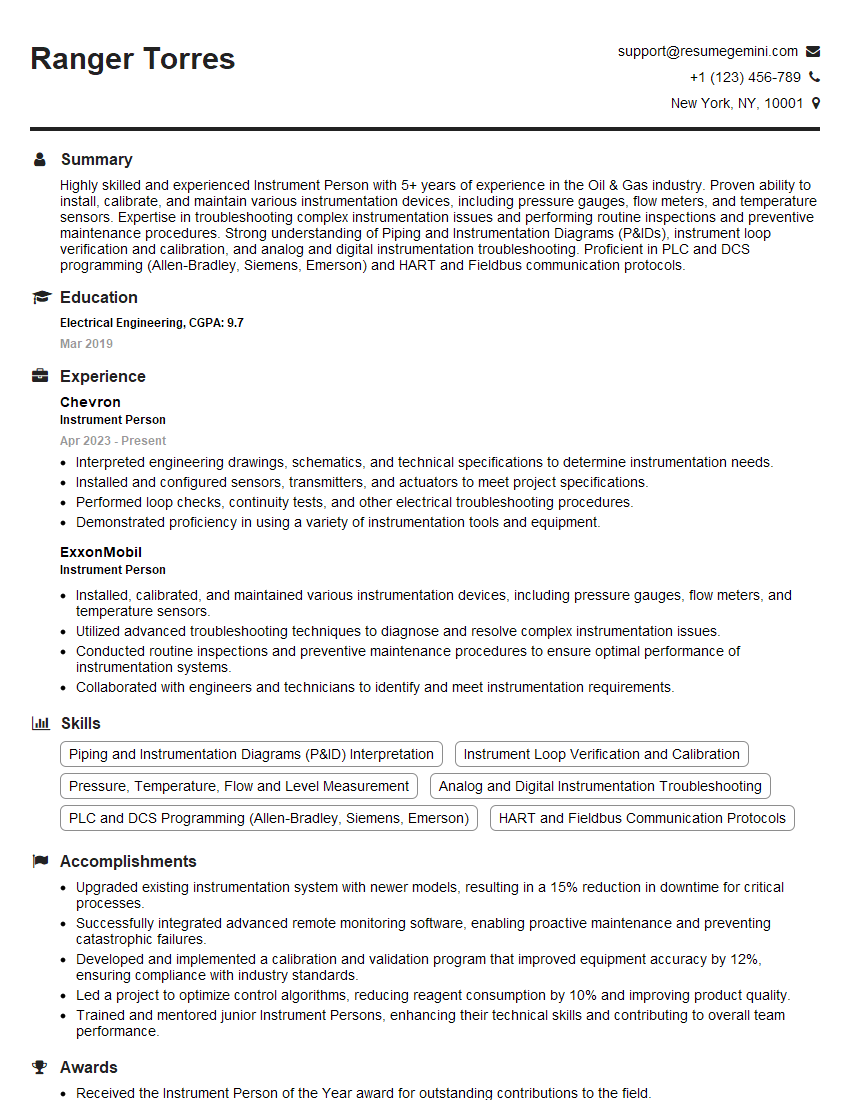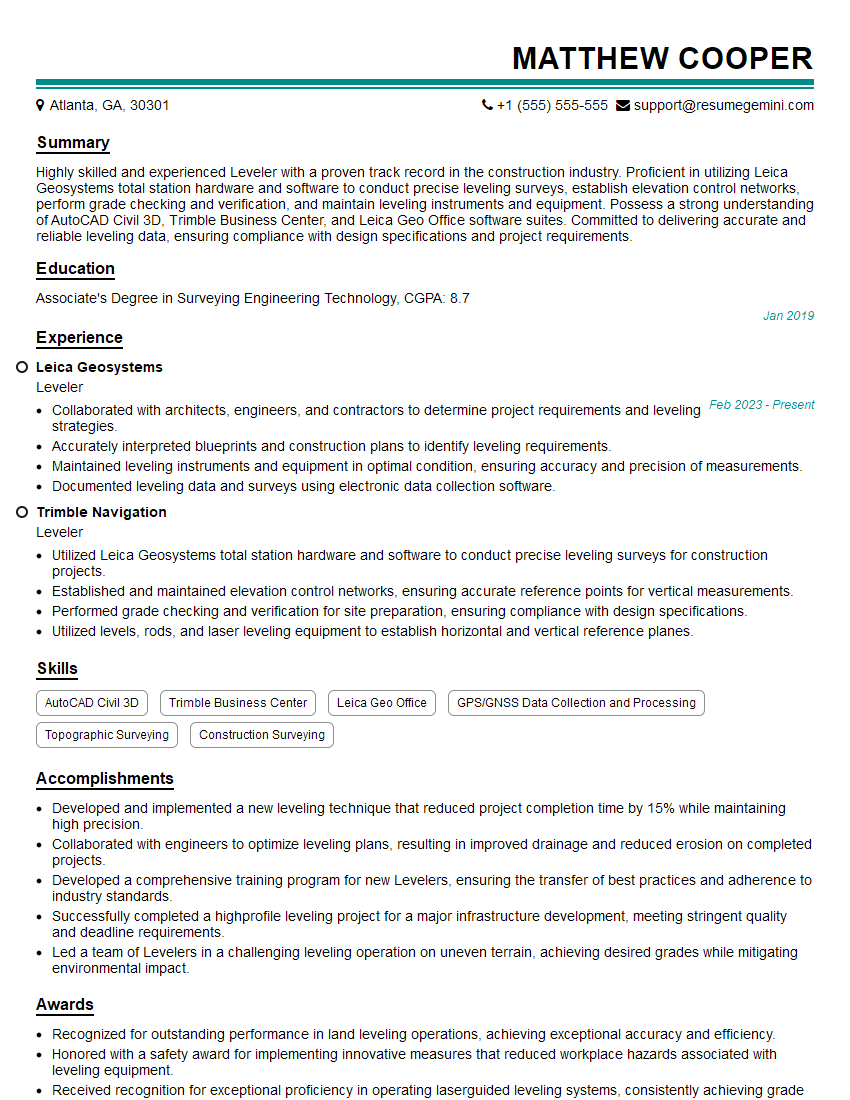Feeling uncertain about what to expect in your upcoming interview? We’ve got you covered! This blog highlights the most important Skilled in using GPS and laser leveling systems interview questions and provides actionable advice to help you stand out as the ideal candidate. Let’s pave the way for your success.
Questions Asked in Skilled in using GPS and laser leveling systems Interview
Q 1. Explain the principles of GPS surveying.
GPS surveying relies on the precise measurement of the time it takes for signals from multiple satellites to reach a receiver on Earth. These satellites transmit signals containing their precise location and the time the signal was sent. By receiving these signals from at least four satellites, the receiver can use trilateration – calculating its position based on the distances to each satellite – to determine its three-dimensional coordinates (latitude, longitude, and elevation). Think of it like finding a treasure using clues from three separate friends who know the distance to the treasure from their locations; with three distances, you can pinpoint its location. GPS uses similar principles but with extremely accurate timing and satellite positions.
Q 2. Describe different types of GPS receivers and their applications.
GPS receivers range from simple handheld units to highly sophisticated geodetic receivers.
- Handheld GPS receivers: These are consumer-grade devices, offering basic positioning accuracy, primarily used for navigation and recreational activities. Accuracy is usually within a few meters.
- Mapping-grade GPS receivers: These are more accurate and offer better signal processing capabilities. They’re commonly used for creating maps and performing basic surveying tasks. Accuracy can reach sub-meter levels.
- Geodetic GPS receivers: These are the most accurate receivers, offering centimeter-level accuracy. They are used in high-precision surveying, engineering, and scientific applications. They often incorporate Real-Time Kinematic (RTK) technology, which I’ll discuss later.
The choice of receiver depends on the project’s accuracy requirements and budget. For instance, a construction site might use mapping-grade receivers, while precise land boundary surveys would demand geodetic receivers.
Q 3. How do you account for atmospheric effects in GPS measurements?
Atmospheric effects, primarily the ionosphere and troposphere, can significantly affect GPS signal propagation. The ionosphere, a layer of charged particles, delays the signal, while the troposphere, the lower atmosphere, causes signal refraction (bending). These effects cause errors in the calculated distance from satellite to receiver.
We account for these effects through atmospheric models and corrections. These models use data on atmospheric conditions (temperature, pressure, humidity) to estimate the delays and apply corrections to the raw GPS measurements. Sophisticated receivers often incorporate real-time atmospheric models, leading to increased accuracy.
For example, some receivers use atmospheric data from weather stations to improve their accuracy further. More advanced techniques involve using dual-frequency receivers that can measure the signal at two different frequencies, allowing them to separate and correct for ionospheric delays more effectively.
Q 4. What are the sources of error in GPS surveying, and how can they be mitigated?
Several error sources can impact GPS surveying accuracy:
- Atmospheric delays: Already discussed above.
- Satellite clock errors: Slight inaccuracies in the satellite’s internal clocks.
- Satellite ephemeris errors: Errors in the satellite’s predicted position.
- Multipath effects: Signals reflecting off surfaces like buildings or water before reaching the receiver.
- Receiver noise: Random electronic noise in the receiver circuitry.
- Obstructions: Trees, buildings, or terrain features blocking the signal.
Mitigation strategies include using differential GPS (DGPS), RTK GPS, precise point positioning (PPP), employing multiple receivers for redundancy, careful site selection to minimize obstructions, and using advanced signal processing techniques to filter out noise.
Q 5. Explain the process of differential GPS (DGPS).
Differential GPS (DGPS) significantly improves accuracy by using a known reference station with a precisely known location. This reference station also receives signals from the same satellites as the roving receiver (the one being used for surveying). The reference station’s position and the differences between its calculated position and its known position (the corrections) are transmitted to the roving receiver. The roving receiver then applies these corrections to its own measurements, drastically reducing errors.
Imagine two people trying to find a specific location using only a map. One person (the roving receiver) has a slightly inaccurate map, while the other (the reference station) has a perfectly accurate map of their known position. The second person can tell the first how much their map is off, allowing the first to correct their position.
Q 6. What is RTK GPS and how does it improve accuracy?
Real-Time Kinematic (RTK) GPS is a highly accurate technique that builds upon DGPS. It uses carrier phase measurements – the precise phase of the GPS signal – to achieve centimeter-level accuracy. Unlike DGPS, which uses pseudo-range measurements (measuring the time it takes the signal to reach the receiver), RTK GPS analyzes the carrier phase, a much finer measurement that reduces errors significantly. This process usually involves a base station and a rover.
RTK GPS offers real-time positioning, meaning the coordinates are available immediately, making it incredibly useful for applications where immediate positioning is crucial such as construction layout or machine guidance. The increased accuracy greatly reduces potential errors and allows for higher-precision work compared to standard GPS techniques.
Q 7. Describe the different types of laser levels.
Laser levels are precision instruments used for leveling and aligning surfaces in construction and other applications. Different types exist:
- Self-leveling laser levels: These automatically level themselves using a pendulum mechanism. They are user-friendly and suitable for most leveling tasks. They automatically correct for minor inclinations in the instrument.
- Rotating laser levels: These project a laser beam that rotates 360 degrees, creating a horizontal or vertical plane. They are efficient for large-scale projects like setting grades and laying out foundations.
- Line laser levels: These project single or multiple laser lines for precise leveling and alignment. They’re excellent for interior work such as hanging drywall or tiling.
- Manual levels: While not strictly laser levels, they are often employed alongside laser systems. They require precise leveling procedures and usually utilize a bubble level to ensure accuracy.
The choice of laser level depends on the project scope and desired precision. Rotating laser levels are ideal for large areas, while line lasers are useful for more detailed interior work. Combining these laser levels with GPS enhances the precision and efficiency of large-scale projects. For example, during the construction of a large building, rotating lasers might be used to establish the foundation levels, while line lasers could be employed for setting walls.
Q 8. How do you set up and calibrate a laser level?
Setting up and calibrating a laser level is crucial for accurate measurements. First, you need a stable, level base – think tripod – to mount the laser level. Ensure the ground is firm and free from vibrations. Then, roughly level the instrument using the built-in bubble level. Most levels have a self-leveling mechanism; once powered on, the laser will automatically level itself within a specific range. However, always double-check the bubble level for maximum accuracy.
Calibration involves ensuring the laser’s horizontal and vertical planes are perfectly level. Many laser levels offer built-in calibration checks. This usually involves rotating the instrument and comparing readings at various points, using a calibrated measuring tape or a second level as a reference. If adjustments are needed (often through internal calibration screws – consult your manual!), follow the manufacturer’s instructions precisely. Remember, a poorly calibrated laser will result in significant errors throughout your project.
For example, when setting up for a foundation, I’d ensure the tripod legs are firmly planted, possibly even placing leveling plates underneath for extra stability on uneven ground. I’d then meticulously check the self-leveling function and visually verify the accuracy of the laser lines using a plumb bob or a long, perfectly straight edge.
Q 9. What are the safety precautions when using laser levels?
Safety is paramount when using laser levels. The most significant risk comes from the laser beam itself, particularly those with higher power.
- Eye Protection: Always wear appropriate laser safety glasses. These glasses are rated to block the specific wavelength of light emitted by your laser level. Never look directly at the laser beam.
- Warning Signs: Post warning signs in areas where the laser beam might be present. This is crucial for alerting anyone who might not be aware of the laser’s operation.
- Proper Training: Ensure that all personnel using the laser level have received proper training on safe operation procedures and laser safety regulations.
- Environmental Considerations: Avoid directing the laser beam at reflective surfaces that could redirect the beam toward people or sensitive equipment.
- Avoid Obstructions: Be mindful of potential obstructions like equipment or personnel, especially during setup and operation.
I once had a situation on a site where a construction worker wasn’t aware of the laser operation, and he almost looked directly into the beam. That’s when I realized the importance of proper communication and site safety protocols. Clear signage and proper safety training prevent such incidents.
Q 10. Explain the process of establishing benchmarks using laser levels.
Establishing benchmarks is fundamental to any leveling project. A benchmark is a permanent, stable point with a known elevation. We use laser levels to establish benchmarks by first selecting a suitable location that’s unlikely to be disturbed. Ideally, this will be something robust like a concrete marker or a firmly fixed bolt in the ground.
The process involves setting up the laser level at a known elevation (or a temporary benchmark) and then using a leveling rod and a digital level to measure the elevation difference between the laser’s horizontal plane and the desired benchmark location. The elevation difference, combined with the known elevation of the instrument setup, provides the elevation of the new benchmark.
For example, I might use a known elevation point – perhaps a municipal benchmark – as my starting reference point. From there, I’d use the laser to create a horizontal plane, precisely measuring the vertical difference to several new locations. These locations would then become benchmarks, giving me reliable elevation references for the entire project, forming a basis for other elevation measurements.
Q 11. How do you measure distances and elevations using a laser level?
Measuring distances and elevations using a laser level involves a leveling rod and, often, a digital level sensor. The laser level projects a horizontal or vertical plane. The leveling rod, marked with graduations in centimeters or feet, is held at the point you need to measure.
For elevation measurement, the laser creates a horizontal plane. The elevation difference is simply the vertical distance between the laser’s plane and the rod’s reading. A digital sensor on the rod can directly transmit this value to a data logger or hand-held receiver for increased accuracy and efficiency. For distance measurement, a separate distance-measuring instrument, or a function on some newer laser levels, may be used. It will directly provide the distance reading. It’s crucial to understand that these laser levels are precise for elevation, but the included distance measurement may not be as accurate as a dedicated distance measuring tool for larger distances.
Imagine grading a slope for a road. We’d establish a benchmark, then, using the laser level and rod at various points along the slope, measure the elevation difference from our established plane. This allows us to determine exactly how much cut or fill is needed at each point.
Q 12. What are the limitations of laser leveling?
While laser leveling is incredibly precise and efficient, it has certain limitations. Firstly, its range is limited by the power of the laser and atmospheric conditions (e.g., fog, heavy rain). Longer distances might require more powerful lasers or even different methods altogether.
Secondly, laser levels can be affected by atmospheric refraction, where the light bends due to temperature gradients. This is more noticeable over long distances, and in situations with extreme temperature differences between ground and air.
Thirdly, proper calibration is crucial. A misaligned or poorly calibrated instrument will lead to inaccurate measurements, which are critical errors during construction. And finally, the laser beam can be obscured by physical obstructions, requiring careful planning and setup to ensure a clear line of sight.
For example, on a large site with many buildings, the laser beam could be obstructed, and you would have to carefully plan multiple setups to cover the entire area, ensuring appropriate overlapping areas to minimize errors.
Q 13. Describe the process of establishing control points for a construction site.
Establishing control points is vital for accurate surveying and construction. Control points are strategically located, precisely surveyed points that form a network across a construction site. These provide a reference framework for all subsequent measurements.
The process often involves using GPS technology to determine the precise coordinates (latitude, longitude, and elevation) of the points. Once these GPS coordinates are established, the locations of these points are transferred to the site using a high-precision total station or Robotic total station. These control points, once established, are permanently marked (e.g., using rebar or concrete markers) to prevent displacement. These permanent markers then serve as benchmarks or references for all other aspects of site layout and construction.
In practice, I might use a combination of GPS base stations and rover units to accurately locate these control points, typically using several independent measurements to enhance accuracy. This could result in a network of points that provide a rigid and highly precise reference system for setting out buildings, foundations, roads, and other features.
Q 14. How do you use GPS and laser leveling in conjunction on a project?
GPS and laser leveling are frequently used in conjunction to achieve higher levels of accuracy and efficiency. GPS provides the horizontal positioning (latitude and longitude), while the laser level provides the vertical positioning (elevation). This synergy is particularly useful in large-scale projects where high precision is essential.
The process typically involves first establishing a network of control points using GPS. Then, the laser level is used to set out individual features within the framework established by the GPS control points. For example, after using GPS to establish a precise elevation at a number of locations, I can use a laser level to ensure the foundations are level across a large site while maintaining accurate positions relative to the GPS-established control points. This ensures both horizontal and vertical accuracy is meticulously maintained.
Consider a large highway project. GPS would be crucial to set the route’s overall alignment and horizontal control. Laser levels would then come into play for accurate grading of the road surface, ensuring precise elevations are achieved consistently along the entire length.
Q 15. Explain the concept of coordinate systems in surveying.
Coordinate systems in surveying are fundamental for defining the location of points in three-dimensional space. They provide a framework for referencing positions accurately. Imagine trying to describe a location without a grid or map – it’s impossible! Coordinate systems provide that grid. Common systems include:
- Geographic Coordinate System (GCS): Uses latitude and longitude, based on the Earth’s spheroid. Think of it like lines of longitude and latitude on a globe. It’s great for global positioning.
- Projected Coordinate System (PCS): Transforms the curved Earth’s surface onto a flat plane. This is essential for mapping and surveying projects as it allows us to use distances and angles directly on a map or plan. Common projections include UTM (Universal Transverse Mercator) and State Plane Coordinate Systems.
Understanding the differences between GCS and PCS is crucial. A GCS gives you a location on the globe, but a PCS is needed for local measurements and calculations on a map. The choice of coordinate system depends heavily on the project’s scale and location.
Career Expert Tips:
- Ace those interviews! Prepare effectively by reviewing the Top 50 Most Common Interview Questions on ResumeGemini.
- Navigate your job search with confidence! Explore a wide range of Career Tips on ResumeGemini. Learn about common challenges and recommendations to overcome them.
- Craft the perfect resume! Master the Art of Resume Writing with ResumeGemini’s guide. Showcase your unique qualifications and achievements effectively.
- Don’t miss out on holiday savings! Build your dream resume with ResumeGemini’s ATS optimized templates.
Q 16. How do you convert between different coordinate systems?
Converting between coordinate systems involves using coordinate transformations, which are mathematical equations. The specific equations depend on the systems involved. For example, converting between a GCS (latitude/longitude) and a PCS often requires a datum transformation, which accounts for the differences between different models of the Earth’s shape (datums). Software packages like ArcGIS and AutoCAD Map 3D handle these complex transformations automatically. The process generally involves providing the software with the source and target coordinate systems’ parameters (datum, projection, etc.).
Let’s say I have coordinates in UTM Zone 17N and need them in a local State Plane Coordinate System. The software would use the defined parameters of both systems, including a possible datum transformation (e.g., from NAD83 to NAD27), to calculate the equivalent coordinates. This often involves using a grid shift file or parameters specific to the region.
Q 17. What software packages are you familiar with for processing surveying data?
I’m proficient in several software packages for processing surveying data, including:
- ArcGIS: A powerful GIS (Geographic Information System) software for managing, analyzing, and visualizing spatial data. I use it for tasks such as creating and managing geodatabases, performing spatial analysis, and generating maps.
- AutoCAD Civil 3D: Specialized for civil engineering projects, including surveying. I use it for creating surface models, designing alignments, and performing volume calculations.
- Trimble Business Center: A post-processing software specifically designed for Trimble GPS data. I use it for processing raw GPS data, applying corrections, and generating precise coordinates.
- MicroStation: Used extensively for CAD drafting and design. This software allows me to incorporate and integrate survey data with other design elements.
My familiarity with these diverse platforms allows me to adapt to different project needs and data formats.
Q 18. Describe your experience with data post-processing techniques.
Data post-processing is crucial for achieving high accuracy in surveying. My experience includes:
- GPS data processing: This involves applying corrections to raw GPS data to account for atmospheric delays, satellite clock errors, and other sources of error. I use software like Trimble Business Center to perform precise point positioning (PPP) or real-time kinematic (RTK) processing, depending on the project requirements. The goal is to achieve centimeter-level accuracy.
- Error detection and adjustment: I regularly analyze data for blunders (gross errors) and outliers. I employ statistical methods and quality control checks to identify and correct or remove these errors. This often involves techniques such as least squares adjustment, ensuring the final results are consistent and reliable.
- Data transformation and coordinate conversion: As mentioned earlier, I utilize software to transform data between different coordinate systems to match project requirements and integrate with other datasets.
A recent project involved processing thousands of GPS points for a large-scale land survey. Through rigorous post-processing, I was able to achieve the required accuracy and deliver a reliable dataset for further analysis and design.
Q 19. How do you handle conflicting measurements obtained from GPS and laser leveling?
Conflicting measurements from GPS and laser leveling require careful analysis. The first step is to identify the source of the discrepancy. This could be due to:
- Instrumental errors: Calibration issues, faulty equipment, or incorrect instrument setup.
- Environmental factors: Atmospheric conditions (for GPS), ground instability, or obstructions.
- Human error: Incorrect measurements, data entry mistakes, or improper procedures.
To resolve the conflict, I investigate each potential source of error. I might re-measure the points in question, check instrument calibration, review field notes and procedures, and assess environmental factors. Often, statistical analysis helps determine which measurement is more reliable. If the discrepancies remain unexplained, I may consult with other professionals or seek additional data to resolve the issue. Ultimately, documentation of the conflict resolution process is crucial.
Q 20. How do you ensure the accuracy of your measurements?
Ensuring accuracy is paramount. My approach is multifaceted:
- Proper equipment calibration and maintenance: Regular calibration of GPS receivers and laser levels ensures accurate readings. I maintain detailed records of calibration checks.
- Rigorous field procedures: Following standardized procedures minimizes human error. This includes careful instrument setup, precise measurements, and thorough documentation.
- Quality control checks: Regular checks and analysis of the data during and after data collection help identify and correct errors early.
- Redundant measurements: Taking multiple measurements of the same point allows for comparison and detection of outliers.
- Environmental considerations: I factor in environmental conditions (temperature, humidity, atmospheric pressure) which can affect accuracy, particularly with GPS measurements.
I always strive for the highest levels of accuracy possible, within the limitations of the equipment and environmental conditions. Knowing the limitations of each instrument and procedure is essential to avoid misleading results.
Q 21. Explain your experience with different types of surveying equipment.
My experience encompasses a range of surveying equipment, including:
- GPS receivers: I’ve used various receivers, from basic handheld units to high-precision RTK systems with multiple antennas. This experience includes handling both static and kinematic GPS surveys.
- Total stations: I’m proficient in using total stations for precise distance, angle, and elevation measurements. I’m experienced with various brands and models, including robotic total stations.
- Laser levels and scanners: I’m experienced in using laser levels for establishing horizontal and vertical control, and laser scanners for creating 3D point clouds of sites. This includes different types of laser levels, from simple self-leveling levels to more sophisticated rotating lasers.
- Data collectors: I’m familiar with using various data collectors for recording and managing survey data in the field, ensuring data integrity.
This breadth of experience allows me to select the most appropriate equipment for each project, optimizing accuracy and efficiency.
Q 22. How do you maintain and troubleshoot surveying equipment?
Maintaining and troubleshooting surveying equipment is crucial for accurate data and project success. It involves a multi-faceted approach encompassing preventative maintenance, regular checks, and effective troubleshooting techniques.
Preventative Maintenance: This includes daily checks of battery levels, ensuring the instrument is clean and free of debris (especially critical for laser levels), and carefully storing the equipment in a climate-controlled environment to prevent damage from extreme temperatures or humidity. Regular calibration checks, ideally according to manufacturer recommendations, are vital for accuracy. For GPS units, this involves updating firmware, checking satellite signal reception quality, and verifying the integrity of the antenna.
Troubleshooting: When problems arise, systematic troubleshooting is essential. For instance, if a laser level is not producing a level beam, I would first check the power source and battery connections. Then I’d inspect for any obstructions in the beam path or issues with the leveling mechanism. Similarly, GPS signal issues are usually addressed by checking for obstructions like tall buildings or dense tree cover, ensuring the receiver has a clear view of the sky, and checking for interference from other electronic devices. If the problem persists, I’d consult the equipment manual and possibly contact the manufacturer’s technical support.
Record Keeping: Maintaining detailed records of maintenance performed, calibration dates, and any repairs is essential for tracking equipment performance and ensuring warranty compliance. This allows for easy identification of patterns and potential future issues.
Q 23. Describe a challenging surveying project you worked on and how you overcame the challenges.
One challenging project involved surveying a steep, heavily wooded hillside for a new road construction. The dense vegetation severely hampered GPS signal reception, causing frequent signal loss and inaccurate readings. The uneven terrain also made it difficult to establish stable reference points for traditional leveling techniques.
To overcome these challenges, we employed a multi-pronged approach. First, we strategically cleared a few small areas to provide unobstructed views of the sky for GPS measurements. We used a combination of RTK (Real-Time Kinematic) GPS, which offers centimeter-level accuracy, and robotic total stations to establish control points and conduct detail surveys. The robotic total station enabled us to efficiently survey points from a distance, bypassing many obstacles. We also used a combination of traditional leveling techniques with laser leveling equipment in areas where GPS was too unreliable. We meticulously documented each step and cross-checked measurements to ensure accuracy. Through meticulous planning, diverse equipment usage, and teamwork, we successfully completed the project within budget and to the client’s specifications.
Q 24. How do you ensure the safety of yourself and your crew on a job site?
Safety is paramount on any surveying job site. My approach involves a proactive, multi-layered safety plan encompassing pre-job planning, on-site vigilance, and adherence to all relevant safety regulations.
Pre-Job Planning: This includes thorough site assessments to identify potential hazards like uneven terrain, overhead power lines, and the presence of wildlife. We develop site-specific safety plans outlining procedures for dealing with these hazards, including appropriate PPE (Personal Protective Equipment) requirements.
On-Site Vigilance: This involves constant monitoring of the work area and ensuring all team members are following established safety procedures. We regularly check equipment for faults and ensure everyone is aware of their surroundings and potential risks. Traffic control measures are employed when working near roads.
Communication: Clear and consistent communication between team members is vital. This includes daily safety briefings, open communication channels for reporting potential hazards, and regular check-ins.
Q 25. What are your skills in data interpretation and reporting?
My skills in data interpretation and reporting are comprehensive. I’m proficient in using surveying software to process raw data from GPS and laser leveling systems, performing calculations, and creating accurate maps, cross-sections, and other deliverables.
I can generate reports in various formats, including detailed technical reports, concise summaries, and easily understandable visualizations for non-technical audiences. I am adept at identifying anomalies or inconsistencies in data and using statistical analysis to improve data quality and reliability. My experience also extends to using GIS (Geographic Information System) software to integrate survey data with other spatial datasets.
Q 26. Describe your experience with working in various terrains and weather conditions.
I have extensive experience working in various terrains, from flat, open areas to challenging mountainous regions and dense urban environments. Weather conditions have also varied widely, from sweltering heat to freezing cold and stormy weather.
My experience in diverse terrains has honed my adaptability and problem-solving abilities. For instance, when working in mountainous areas, careful planning of traverse lines and careful handling of equipment are crucial. In urban settings, I’m adept at navigating complex infrastructure and managing challenges associated with restricted access. Adapting to challenging weather conditions involves making use of appropriate protective gear and adjusting work schedules to minimize risks. My experience allows me to maintain efficiency and accuracy even under difficult circumstances.
Q 27. Are you familiar with relevant safety regulations and standards?
Yes, I am thoroughly familiar with relevant safety regulations and standards. My knowledge encompasses OSHA (Occupational Safety and Health Administration) guidelines, local and state regulations regarding surveying operations, and industry best practices. I am well-versed in safety protocols for working with surveying equipment, handling hazardous materials, and operating in potentially dangerous environments.
I’m also up-to-date on the latest safety technologies and equipment, and I always prioritize safety in my work and encourage safe practices in my team.
Q 28. What are your salary expectations?
My salary expectations are commensurate with my experience and skill set, and competitive within the industry. I’m open to discussing this further once I have a better understanding of the specific requirements and benefits package associated with the position.
Key Topics to Learn for Skilled in using GPS and Laser Leveling Systems Interview
- GPS Fundamentals: Understanding GPS signal reception, accuracy limitations (e.g., multipath errors, atmospheric effects), and different GPS technologies (e.g., RTK, PPK).
- Laser Leveling Principles: Grasping the concepts of leveling, grade control, and the operation of various laser leveling instruments (rotary lasers, line lasers).
- Data Acquisition and Processing: Familiarity with data logging procedures, software for data analysis and interpretation (e.g., post-processing software for GPS data), and understanding of error analysis.
- Practical Applications: Understanding the use of GPS and laser leveling in various fields, such as construction, surveying, and agriculture. Be ready to discuss specific projects or experiences where you utilized these technologies.
- Troubleshooting and Problem Solving: Describe your experience identifying and resolving issues related to equipment malfunction, signal interference, or inaccurate readings. Demonstrate your analytical and problem-solving skills.
- Safety Procedures: Highlight your knowledge of safety regulations and best practices related to operating GPS and laser leveling equipment in various environments.
- Different types of GPS receivers and their applications: Discuss the pros and cons of different types of receivers in specific contexts.
- Calibration and Maintenance: Describe your understanding of the calibration and maintenance procedures for both GPS and laser leveling equipment.
Next Steps
Mastering GPS and laser leveling systems is crucial for advancement in many high-demand fields. Proficiency in these technologies demonstrates valuable skills in precision, accuracy, and problem-solving, leading to increased career opportunities and higher earning potential. To maximize your job prospects, create a strong, ATS-friendly resume that highlights your expertise. ResumeGemini can help you build a professional, impactful resume tailored to showcase your skills. Examples of resumes tailored to highlight proficiency in GPS and laser leveling systems are available to help you get started.
Explore more articles
Users Rating of Our Blogs
Share Your Experience
We value your feedback! Please rate our content and share your thoughts (optional).
What Readers Say About Our Blog
To the interviewgemini.com Webmaster.
Very helpful and content specific questions to help prepare me for my interview!
Thank you
To the interviewgemini.com Webmaster.
This was kind of a unique content I found around the specialized skills. Very helpful questions and good detailed answers.
Very Helpful blog, thank you Interviewgemini team.










